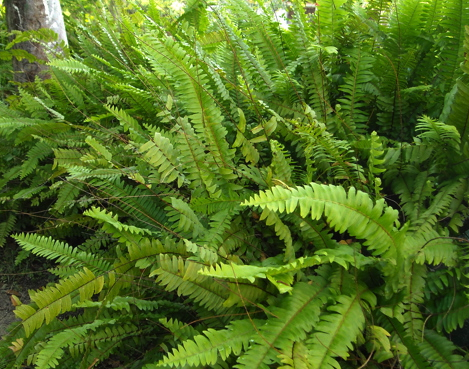The native flora of Hawai'i have a deserved reputation for being difficult to grow, at least in the context of our artificial suburban landscapes. Most natives evolved in response to the islands many microclimates, and their cultural requirements are specific. They can't survive the abuse that we dole out to most landscapes: imported soils, imported ornamental plants, chemical fertilizers, badly-programmed automatic irrigation systems and poorly-trained landscape crews with power tools.
In a more ideal world, we would let go of our artificial suburban landscapes and restore native landscapes and landscape systems. But even for folks who want to grow natives and have more sustainable landscapes, the cost of renovating a landscape is prohibitive. Until then, we need to look for those natives that are better adapted to what exists in most backyards. Here's a plant that's almost foolproof.
Known in Hawaii as Kupukupu, and elsewhere as Sword Fern or Narrow Sword Fern (botanical name Nephrolepis cordifolia), this short, bright green fern is as tough as they come. It thrives on lava fields and can be found on both the wet and dry sides of the island. Obviously it can take heat, but it is surprisingly cold resistant. Though Sunset's Western Garden Book says it will not withstand hard freezes, I used it in a tropical-style garden in the Central Valley of California, where it thrived despite temperature ranging from freezing to 105 degrees F. It will survive over-watering, and is surprisingly drought-tolerant. What's not to like? The only complaint one can have with this beautiful, tropical plant is that it is a little too hearty and can be invasive (tough, adaptive plants that survive landscape crews and unlucky gardeners usually are invasive--the flip side of their tenacity). Plant it alongside water features or in low border areas (it typically grows from 12" to 24"). Give it room to spread, at least 24", if you are planting it en masse. It will be less maintenance if it has a hard border to keep it from spreading. It looks lovely mixed with Hawaiian Ti plants and other common tropical plants. Aside from digging out clumps that may roam beyond the desired borders, this fern takes little care. It tolerates a broad range of soils, but likes a slightly acidic soil best. You can address that issue by using mulch around it, which tends to acidify the soil slightly after it breaks down. It welcomes organic fertilizer in the form of organic compost and chicken manure or worm castings, fish fertilizer, or compost tea, and if you are using bark mulch, it's good practice to fertilize before you install fresh mulch, so that the plants won't be deprived of nitrogen as the mulch first begins to break down. Regular watering, either overhead or drip works well, but don't let the roots stay waterlogged. It will survive the occasional drenching just fine, provided it has good drainage. You can find it at native Hawaiian plant nurseries as well as many tropical plant nurseries.
Comments on this entry are closed.